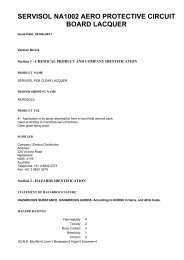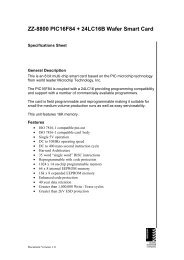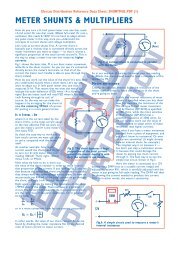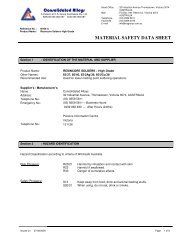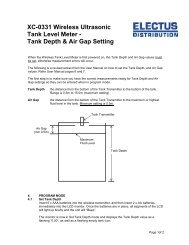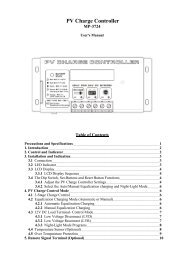OPTOCOUPLERS: - Jaycar Electronics
OPTOCOUPLERS: - Jaycar Electronics
OPTOCOUPLERS: - Jaycar Electronics
You also want an ePaper? Increase the reach of your titles
YUMPU automatically turns print PDFs into web optimized ePapers that Google loves.
Electus Distribution Reference Data Sheet: OPTOCOUP.PDF (2)Fig.4: The output driving a gate in pull-up (A) orpull-down (B) mode.signal that is compatible with our output circuitry.For example just like a discrete LED, you can drive anoptocoupler’s input LED from a transistor or logicgate/buffer. All that’s needed is a series resistor to set thecurrent level when the LED is turned on. And regardless ofwhether you use a transistor or logic buffer to drive theLED, you still have the option of driving it in ‘pull down’ or‘pull up’ mode — see Fig.2. This means you can arrange forthe LED, and hence the optocoupler, to be either ‘on’ or‘off’ for a logic high (or low) in the driving circuitry.In some circuits, there may be a chance that at times thedriving voltage fed to the input LED could have reversedpolarity (due to a swapped cable connection, for example).This can cause damage to the device, because optocouplerLEDs tend to have quite a low reverse voltage rating:typically only 3 - 5V. So if this is a possibility, a reversedpolaritydiode should be connected directly across the LEDas shown in Fig.3.On the output side, there are again a number of possibleconnections even with a typical optocoupler of the typehaving a single phototransistor receiver (such as the 4N25or 4N28). In most cases the transistor is simply connectedas a light-operated switch, in series with a load resistor RL(see Fig.4). The base of the transistor is left unconnected,and the choice is between having the transistor at the topof the load resistor (Fig.4A) or at the bottom (Fig.4B) —i.e., in either pull-up or pull-down mode. This again givesplenty of flexibility for driving either logic gates ortransistors, as shown in Fig.5.If a higher bandwidth is needed, this can be achieved byusing only the collector and base connections, and usingthe transistor as a photodiode (Fig.6A). This lowers theoptocoupler’s CTR and transfer gain considerably, but canincrease the bandwidth to 30MHz or so. An alternativeFig.5: Driving a transistor in either pull-up (A) orpull-down (B) mode.approach is still to use the output device as a phototransistor,but tie the base down to ground (or the emitter)via a resistor Rb, to assist in removal of stored charge(Fig.6B). This can extend the opto’s bandwidth usefully(although not dramatically), without lowering the CTR andtransfer gain any more than is necessary. Typically you’dstart with a resistor value of 1MΩ, and reduce it graduallydown to about 47kΩ to see if the desired bandwidth canbe reached.A variation on the standard optocoupler with a singleoutput phototransistor is the type having a photo-Darlington transistor pair in the output (Fig.7), such as the6N138. As mentioned earlier this type of device gives amuch higher CTR and transfer gain, but with a significantpenalty in terms of bandwidth. Connecting a base tiebackresistor as in Fig.7B can again allow a useful extension ofbandwidth without sacrificing too much in terms of transfergain.Fig.7: The two main output options with a Darlingtontypeopto are again either leaving the base pin floating(A), for high gain but slow operation, or (B) pulling itto ground via a resistor Rb, to trade gain for speed.Fig.6: To increase an opto’s operating speed, you caneither use the output transistor’s collector-basejunction as a photodiode (A) or use a base resistorRb to assist in removing carriers from the base (B).Fig.8: How a opto having an output diac is typicallyused to trigger a triac, for either mains switchingor conduction-angle control.
Electus Distribution Reference Data Sheet: OPTOCOUP.PDF (3)The other main type of optocoupler you’ll tend toencounter is the type having an output diac or bilateralswitch, and intended for use in driving a triac or SCR.Examples of these are the MOC3020 and MOC3021. Herethe output side of the optocoupler is designed to beconnected directly into the triggering circuit of the triac(Fig.8), where it’s operating from and floating at full ACmains potential.As you’d expect the output diac is connected into the triacgate triggering circuit in much the same way as a discretediac. You need a filter/delay circuit before the diac (R1-2and C1) and the usual snubber circuit across the triac (Rs,Cs) to ensure correct triggering with inductive loads.Normally you’d also need at least an RFI suppressor chokeLRFI as well, plus a suitable capacitor across the load.Basic performance specs for the optocouplers stocked byElectus Distribution are shown in the table at right, whiletheir pin connections are shown at top right.Common Optocoupler Connectionsand Basic Specs(Copyright © 2001, Electus Distribution)




